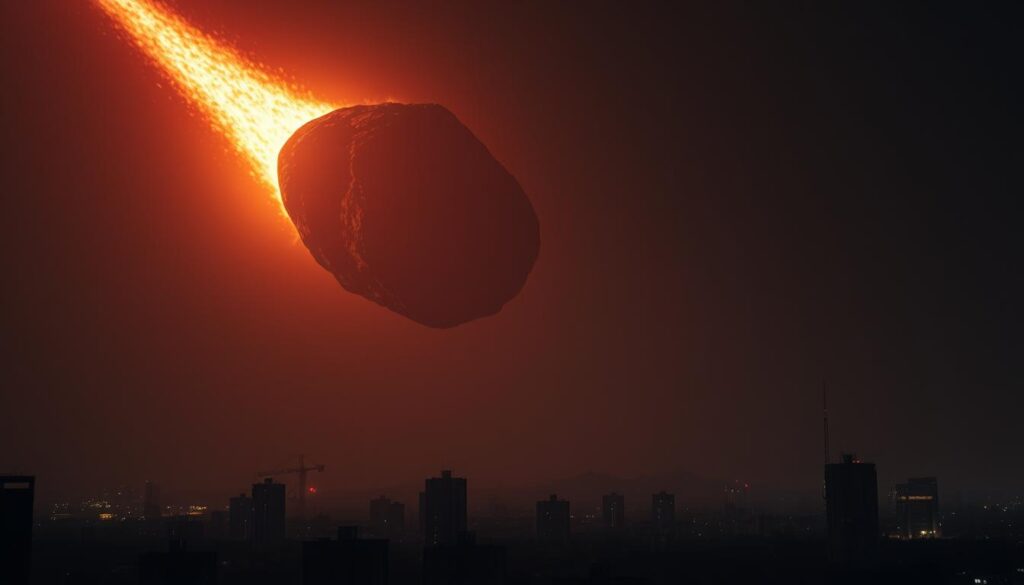Nostradamus, the 16th-century French astrologer, remains a figure of fascination. His cryptic prophecies have intrigued generations, blending historical mysticism with modern curiosity. As we approach 2025, his forecasts are gaining renewed attention amid global tensions and scientific advancements.
From potential asteroid threats to disease resurgence and geopolitical shifts, his predictions touch on pressing concerns. This article explores these forecasts, comparing them with expert opinions to provide a balanced perspective. The blend of ancient wisdom and contemporary analysis offers a unique lens on the future.
Why does Nostradamus’ work continue to captivate us? Perhaps it’s the allure of peering into the unknown or the desire to prepare for what lies ahead. Whatever the reason, his predictions for 2025 invite us to reflect on the challenges and possibilities of the coming year.
Key Takeaways
- Nostradamus was a 16th-century astrologer known for his cryptic prophecies.
- His predictions for 2025 include asteroid threats and disease resurgence.
- Global tensions and scientific advancements make his forecasts relevant today.
- This article compares his predictions with modern expert opinions.
- The blend of historical mysticism and contemporary concerns drives public interest.
Who Was Nostradamus and Why Are His Predictions Relevant?
Michel de Nostredame, known for his enigmatic writings, has left a lasting mark on history. Born in 1503, this French astrologer and physician lived during the Renaissance, a time of great intellectual and cultural change. His work, particularly his 1555 book *Les Prophéties*, contains 942 poetic quatrains that continue to intrigue scholars and enthusiasts alike.

Nostradamus’ methodology was unique. He combined astrology with symbolic language, crafting verses that were intentionally vague. This allowed for multiple interpretations, making his prophecies adaptable to various events. Some claim his writings foresaw significant moments in history, such as Hitler’s rise, the 9/11 attacks, and even the COVID-19 pandemic.
The Life and Legacy of Nostradamus
Nostradamus’ life was marked by both tragedy and triumph. He lost his first wife and children to the plague, which deeply influenced his work. Later, he gained fame as a healer and seer, earning the patronage of royalty. His ability to blend science and mysticism set him apart from his contemporaries.
His legacy, however, is not without controversy. Claims that he predicted Queen Elizabeth II’s death or other specific events are often disputed. Yet, the allure of his prophecies persists, especially in times of uncertainty.
Why His Predictions Still Captivate Us
In today’s world, Nostradamus’ writings resonate deeply. During the post-COVID era, many turned to his prophecies for insight into the future. Social media has amplified this fascination, with viral interpretations linking his verses to current events, such as Pope Francis’ passing.
People gravitate to his work because it offers a sense of control in an unpredictable world. Whether his predictions are accurate or not, they provide a lens through which we can explore our fears and hopes for the future.
Nostradamus Predictions 2025: A Glimpse into the Future
The year 2025 looms large, with ancient prophecies hinting at both challenges and breakthroughs. These forecasts, though centuries old, seem eerily relevant today. From cosmic threats to medical miracles, they paint a picture of a world on the brink of transformation.

Overview of Key Predictions for 2025
Several major themes emerge from the seer’s writings. An asteroid encounter, a resurgence of disease, and a resolution to the Russia-Ukraine conflict are among the most discussed. These predictions blend apocalyptic warnings with glimmers of hope, reflecting the duality of human experience.
For instance, while an economic collapse is foretold, medical breakthroughs are also predicted. This balance of doom and optimism makes these forecasts particularly compelling. They resonate with our deepest fears and highest aspirations.
“The future is not set in stone, but the past offers clues to what may come.”
Modern figures like Athos Salomé have extended this legacy, offering new interpretations of ancient texts. Their work keeps the conversation alive, bridging the gap between history and the present. Yet, skepticism remains. Critics argue that the vague phrasing of these prophecies allows for retroactive interpretations, making them seem more accurate than they are.
Despite this, these forecasts serve as a lens to examine contemporary anxieties. Climate change, pandemics, and political instability are all reflected in these ancient verses. They remind us that while the world changes, human concerns remain constant.
| Prediction | Nature | Impact |
|---|---|---|
| Asteroid Encounter | Apocalyptic | Global Threat |
| Plague Resurgence | Health Crisis | Public Fear |
| Russia-Ukraine Resolution | Geopolitical | Peace Prospects |
| Economic Collapse | Financial | Global Turmoil |
| Medical Breakthroughs | Hopeful | Scientific Progress |
As we approach 2025, these predictions invite us to reflect on the challenges and opportunities ahead. Whether they come to pass or not, they offer a unique perspective on the future.
Asteroid Encounter: Earth’s Close Call in 2025
The cosmos has always been a source of mystery and fear, with celestial events sparking both awe and dread. Throughout history, humanity has interpreted the movements of the stars as omens, often predicting the end of the world or significant upheaval. In 2025, this ancient fascination takes on new relevance as discussions about asteroid threats resurface.

Nostradamus’ Warning of a Potential Collision
Centuries ago, the enigmatic seer wrote about celestial threats that would cause widespread panic. His quatrains describe a “great fire from the sky” and “stones falling from heaven,” which many interpret as references to an asteroid collision. While his forecasts are poetic and vague, they continue to capture the imagination of those who seek meaning in the unknown.
“The sky will burn at forty-five degrees, fire approaches the great new city.”
Scientific Perspectives on Asteroid Threats
Modern science offers a more grounded view of these celestial dangers. Astronomers track hundreds of near-Earth asteroids yearly, but none currently pose a collision risk in 2025. NASA’s DART mission, which successfully altered an asteroid’s trajectory in 2022, demonstrates humanity’s growing ability to defend against such threats.
The 2029 flyby of the asteroid Apophis serves as a real-world example of close encounters. While it will pass within 19,000 miles of Earth, scientists assure us it poses no danger. However, such events remind us of the importance of planetary defense and ongoing research.
Despite these reassurances, viral prophecies and sensationalized interpretations of ancient texts continue to influence public perception. While it’s essential to acknowledge legitimate concerns, it’s equally important to separate fact from fiction. For a deeper dive into how science intersects with ancient beliefs, explore this insightful article.
The Resurgence of an Old Plague in England
The specter of disease has haunted humanity for centuries, shaping history and culture. From the Black Death to the Spanish Flu, outbreaks have left indelible marks on societies. Today, as we navigate the aftermath of COVID-19, fears of another pandemic loom large. Ancient warnings about an “old plague” resurfacing in England seem eerily relevant.

A Prophecy of Disease
Centuries ago, a seer wrote about the return of a devastating illness. Described as an “old plague,” this prediction has sparked debates among scholars. Some interpret it as a bacterial outbreak, while others see it as a viral resurgence. The vagueness of the phrasing allows for multiple interpretations, making it adaptable to modern concerns.
“The earth shall tremble, and the old plague shall rise again.”
Modern Concerns About Infectious Diseases
Recent events have amplified these fears. The 2022 Strep A outbreak in the UK serves as a stark reminder of how quickly diseases can spread. Antibiotic resistance and climate change further complicate the picture, creating fertile ground for new pathogens. The WHO’s Disease X initiative highlights the need to prepare for unknown threats.
- Post-COVID fears: The pandemic has heightened awareness of zoonotic diseases.
- Health struggles: Antibiotic resistance poses a growing challenge to modern medicine.
- Climate impact: Rising temperatures may facilitate the spread of infectious diseases.
As we age, the lessons of history become more critical. Whether these prophecies come to pass or not, they remind us of the importance of vigilance. For more insights into how ancient wisdom intersects with modern science, explore this article.
Resolution of the Russia-Ukraine Conflict
The Russia-Ukraine conflict has dominated global headlines, but ancient writings hint at a potential resolution. Centuries-old prophecies suggest that exhaustion and resource depletion could pave the way for peace. As we approach 2025, these predictions gain relevance amid ongoing geopolitical tensions.

Nostradamus’ Vision of Peace
Ancient texts describe a time when armies would grow weary, and leaders would seek an end to prolonged conflict. One prophecy speaks of “exhausted soldiers and depleted lands,” suggesting that economic strain could force negotiations. This aligns with modern discussions about “war fatigue” and its impact on prolonged conflicts.
“When the earth is drained, peace shall rise from the ashes of war.”
Current Geopolitical Tensions and Predictions
Today, the battlefield remains at a stalemate, with fluctuating Western aid influencing Ukraine’s resilience. Economic pressures on both sides could lead to a shift in power dynamics. Potential scenarios include a frozen conflict, territorial compromises, or even regime change.
Historically, peace treaties have often been brokered under similar economic strains. For example, the Treaty of Versailles followed the exhaustion of World War I. Could 2025 see a similar resolution?
| Scenario | Description | Likelihood |
|---|---|---|
| Frozen Conflict | Continued stalemate with no clear resolution | High |
| Territorial Compromises | Negotiated land agreements | Medium |
| Regime Change | Shift in leadership altering the conflict’s course | Low |
Modern figures like Craig Hamilton-Parker have also weighed in, predicting political shifts unrelated to the conflict. For instance, his forecast about Keir Starmer’s potential ouster highlights the ongoing fascination with prophecy in uncertain times.
Whether these ancient predictions come to pass or not, they offer a lens through which we can examine the complexities of global conflict and the pursuit of peace.
Global Economic Collapse: A Grim Forecast
The global economy has always been a fragile system, vulnerable to sudden shifts and unforeseen crises. In these uncertain economic times, ancient warnings about financial turmoil are gaining attention. The year 2025 could be a turning point, with rising inflation, debt crises, and unemployment posing significant threats.

Nostradamus’ Warning of Financial Turmoil
Centuries ago, a seer described a period of “financial darkness” marked by widespread hardship. His poetic imagery of economic collapse resonates today as experts predict potential recession risks. The vagueness of these prophecies allows them to adapt to modern concerns, making them eerily relevant.
“When the markets fall, the people shall rise in despair.”
Economic Challenges Facing the World in 2025
The IMF has issued warnings about unsustainable debt levels in major economies like China and the U.S. Developing nations are also at risk, with many already facing severe financial struggles. These pressures could destabilize the global market, leading to widespread uncertainty.
Modern stressors like crypto market volatility and AI-driven job displacement add to the complexity. While technology offers opportunities, it also creates new challenges for workers and investors alike. Balancing innovation with economic stability will be crucial in the coming years.
On a brighter note, green energy investments could offset some of these crises. Renewable energy projects are creating jobs and driving economic growth, offering a glimmer of hope in these turbulent economic times. For the latest updates on global finance, consider subscribing to the Economic Times WhatsApp channel.
Medical Breakthroughs: A Silver Lining
Amidst the uncertainties of the future, advancements in medical science offer a beacon of hope. While many ancient prophecies focus on doom and gloom, some rare quatrains speak of “vanquishing ancient maladies,” hinting at a brighter tomorrow. These optimistic forecasts align with the rapid progress we’re witnessing in healthcare today.

Ancient Visions of Healing
Centuries ago, a seer wrote about the eradication of long-standing illnesses. His poetic verses describe a time when humanity would conquer diseases that once seemed insurmountable. While these predictions are shrouded in mystique, they resonate with the strides we’re making in modern medical research.
“The old shall be made new, and the sick shall rise in health.”
Modern Innovations Shaping the Future
Today, breakthroughs in biotechnology and pharmaceuticals are turning these ancient visions into reality. Alzheimer’s drugs like lecanemab are showing promise in slowing cognitive decline, offering hope to millions. Anti-aging biotechnology is advancing rapidly, with treatments aimed at extending life and improving its quality.
mRNA vaccines, which gained prominence during the COVID-19 pandemic, are now being explored for other diseases, including cancer and HIV. These innovations are not just scientific achievements but also potential game-changers for global health.
Real-world events, such as the WHO’s Pandemic Accord negotiations, underscore the importance of these advancements. As we prepare for the future, the intersection of ancient wisdom and modern science offers a unique perspective on what’s possible.
While the prophetic allure of these predictions captivates us, it’s the tangible progress in clinical trials and research that truly inspires. The journey to a healthier world is ongoing, and these breakthroughs remind us of the power of human ingenuity.
Conclusion: Should We Take Nostradamus’ Predictions Seriously?
The allure of ancient prophecies continues to captivate minds, blending mystery with modern curiosity. While these predictions often resonate with people, their lack of empirical evidence raises questions. For instance, interpretations of events like Pope Francis’ death evolve post-fact, highlighting the role of confirmation bias.
Figures dubbed the “Living Nostradamus” have had mixed accuracy, from vague COVID predictions to failed forecasts. This inconsistency reminds us to approach such claims critically. Linking vague quatrains to specific events, like Trump’s alleged assassination attempt, often relies on selective interpretation.
While ancient lore offers intrigue, staying informed through credible news is essential. Appreciating historical prophecies can be fascinating, but it’s equally important to focus on the future with a grounded perspective. As we look ahead, what might 2026 hold? The mystery continues.

